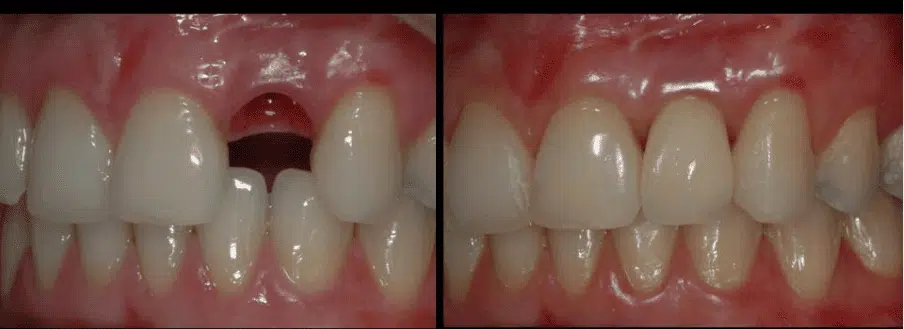The Maryland Adhesive Bridge: The perfect solution and alternative to implants in case of the absence of a single tooth
With its innovative and natural design, this dental bridge offers a highly aesthetic solution to replace one or more missing teeth, either permanently or temporarily (while a dental implant heals).
Unlike other traditional dental bridges, this bridge does not require wearing down adjacent teeth for placement. Instead, it uses a metal or ceramic framework that is bonded to the back of adjacent teeth, meaning there is no need to grind down healthy teeth.
Its beauty lies in its ability to provide a natural and long-lasting appearance. The material used is stain resistant and adapts perfectly to the shape and color of your existing teeth. This ensures that no one will notice the difference between your natural teeth and the bridge.
Remember, Maryland Bridge not only improves your appearance, it also restores full functionality to your mouth. You can talk, eat and laugh with confidence, knowing that your smile will stay bright and beautiful for a long time.
Don’t settle for an incomplete smile. Discover how the Maryland Bridge can transform your dental life.

Table of Content
To understand what a Maryland bridge is, we must first define what an adhesive bridge is as a dental prosthetic technique.
An adhesive bridge is a type of fixed dental bridge of one or more pieces, which instead of being supported by a dental crown on a neighboring natural tooth (carved in the form of a stump or abutment), is supported directly on the neighboring natural tooth to which It has been prepared in a minimally invasive way to house a “fin” that is glued with special state-of-the-art adhesives.
This adhesion can be carried out on different surfaces of the tooth:
It is a type of adhesive bridge that is held on the lingual surface of neighboring teeth but using only flattened, medically made structures known as “fins.”
In this way, it is not necessary to carve or wear down the healthy teeth neighboring the site where you want to recover the lost tooth. Only if the fins are made of ceramic or porcelain, minimal wear is necessary to increase the resistance of the structure.
They are a more economical option than implant-supported crowns because it has the advantage of being a fixed bridge and surgery is not necessary to place a dental implant. On the other hand, since it does not have a dental implant to support it, its resistance is lower, so you have to be much more careful.
Yes, the Maryland is an adhesive bridge, the differentiation lies mainly in:
The Maryland bridge is placed using a special dental bonding material that ensures a secure and long-lasting hold.
The metal or ceramic framework is bonded to the back of adjacent teeth, creating a strong bond that holds the bridge in place. This technique minimizes the need for invasive tooth preparation and offers a more conservative and less traumatic solution.
The Maryland bridge is an excellent option for those who have lost a tooth (preferably anterior, maximum up to a premolar, depending on the case) and want to restore their smile in an aesthetic and functional way and at a lower cost than a single dental implant.
However, not all patients are ideal candidates for this type of bridge. It is important to consult a qualified dentist to evaluate your individual case and determine if the Maryland bridge is right for you.
There are factors such as sex, age, the quality of the enamel and periodontal status of the neighboring teeth, as well as the patient’s hygiene habits.
The process usually involves several stages, including:
Proper care and regular maintenance are essential to ensure that your bridge remains in good condition for many years. Here are some tips for the care and maintenance of your bridge:
The duration can vary depending on several factors, such as oral care, overall oral health, and the quality of the bridge. However, with proper care and regular maintenance, a well-maintained Maryland bridge can last ten to fifteen years or even longer.
The cost can vary depending on several factors, such as the complexity of the case, geographic location, the dentist’s experience and the preparation material. It is important to consult with your dentist to obtain an accurate quote and understand the financial details before proceeding with treatment.
In Quito, Ecuador is one of the places where you can opt for dental treatments at affordable prices.
While the Maryland bridge may be an excellent option for many patients, there are alternatives that may be more suitable in certain cases. Some of the common alternatives including
It is essential to discuss all options with your dentist to find the best solution for your specific dental situation.
The Maryland bridge offers an aesthetic and functional solution for those who want to restore their smile and replace missing teeth. With its innovative design, high-quality materials, and ability to preserve adjacent teeth, the Maryland bridge provides long-lasting, natural results.
If you are looking for a reliable and aesthetic solution for your smile and cannot afford a dental implant, consider the Maryland bridge as an excellent option, whether temporary or permanent.
Consult your dentist to learn more and take the first step toward a bright, long-lasting smile. Don’t settle for an incomplete smile!
Publicado el: 14 May, 2024
More info?